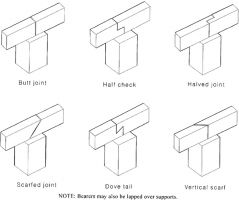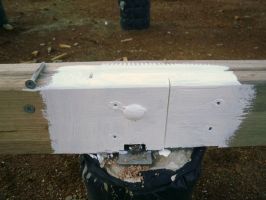|
Selecting fallen-down trees for building posts: the heavier, drier, and denser they are, the better. Some timbers can be placed in the ground, and be debarked, whereas others will rot or grow fungi if so treated.
kellyjones00 (593)
|
|
|
|
Choosing structural timbers: for bearers and joists, laminated veneer lumber (LVL) is straighter and stronger than normal dried dressed timber. This means it is easier to get the base of the building level, and bows and bumps don't need to be planed off before cladding the floor.
kellyjones00 (593)
|
|
|
|
Sorting: When timber is delivered, sort it into types (e.g. bearers, joists, studs, plates, rafters, beams, etc.) and stack in ordered piles on piers off the ground, with airflow around all timber members. Ensure the bowed edge is weighted down and all bows are aligned. Leaving timber unweighted will cause the timbers to dry according to the coil of wood-fibres, and warp fixedly.
kellyjones00 (593)
|
|
|
|
Delivery charges: Generally, lumber over six metres will need a crane to unload, increasing delivery charges substantially. To avoid this, opt for shorter lengths and join the timbers.
kellyjones00 (593)
|
|
|
Joins: It is better to avoid joining runs of structural members, and use whole lengths instead.
Some standard structural joints of dressed timbers:
- Butt: The weakest type of join, where two ends meet along a straight line or at right angles. Butt-jointed timbers in a straight line need extra securing, e.g. with a cleat.
- Cleat: For securing butt-joined wall plates, joists, or ridge beams, preferably in non-loadbearing sections. The cleat is a piece of timber the same depth and width as those to be joined, is nailed to both, like a bandaid on skin.
- Scarf: Like a butt join, but the cut is diagonal rather than at a right-angle to the length. A bolt can run through both timbers across the join. The cut can be on a horizontal or vertical plane relative to the timbers, depending on whether the securing bolt runs horizontally or vertically through the timbers.
- Lap / Splice / Halved: The two pieces of timber overlap, either in a straight line or on a right-angle. Each lap is nailed or screwed to the other. This is a stronger type of join than those above. This is a typical strengthening joint at wall junctions at outer corners and sometimes partitions, and is seen in both the top and bottom wall plates.
- Mortice and tenon: tab into slot, often used with doors and windows, or with greenwood poles and secured with wooden dowels.
- Half check: A horizontal lap join, more suitable for bearers. A single bolt can run vertically through both laps, or a bolt to each timber separately, so long as a nail plate holds the two pieces together.
- Notching: This technique of supporting studs inside chiselled-out notches in the wall plates has been succeeded by better bracing and tie-downs.
kellyjones00 (593)

Click to enlarge
|
|
|
|
Joining bearers: Avoid joins where possible, and only where fully supported by a stump or other support. Bearers must be anchored to all stumps, by for example hot-dipped galvanised bolts, hoop straps, steel rod, and so on.
kellyjones00 (593)
|
|
|
|
Levelling: For bearers, choose to install the two outermost bearers first. Erect a very taut string line as a levelling guide of the top of the first bearer. After securing this bearer, do the other outermost bearer in the same way. Then run string lines between both bearers to guide the levelling of all intermediate bearers.
kellyjones00 (593)
|
|
|
|
Cogging: Measure floor joists to check they are all the same width. The narrowest width is the standard. Wherever all other joists cross the bearer, they are cogged, which is to chisel off excess at the bottom edge supported by the bearer. This ensures the floor is level.
kellyjones00 (593)
|
|
|
|
Cutting scheme: Ensure the timber order is specified so you have enough of the right lengths. Of stud timbers, first cut standard studs, then trimmer studs (for either side of windows and doors, supporting the lintel or header timber), then sills, then jack studs (sitting above and/or below the window and door openings), then standard noggs, then smaller odd noggs. Leave bowed timbers for noggs.
kellyjones00 (593)
|
|
|
|
Bowed pieces of timber should be placed with the bow upwards so that any weight on it helps to straighten it.
kellyjones00 (593)
|
|
|
Preserving timber: The cut ends are like masses of tiny straws, sucking up moisture. For this reason, lumber ends should always be covered by other timber, or capped with metal, or painted.
kellyjones00 (593)

Click to enlarge
|
|
|
